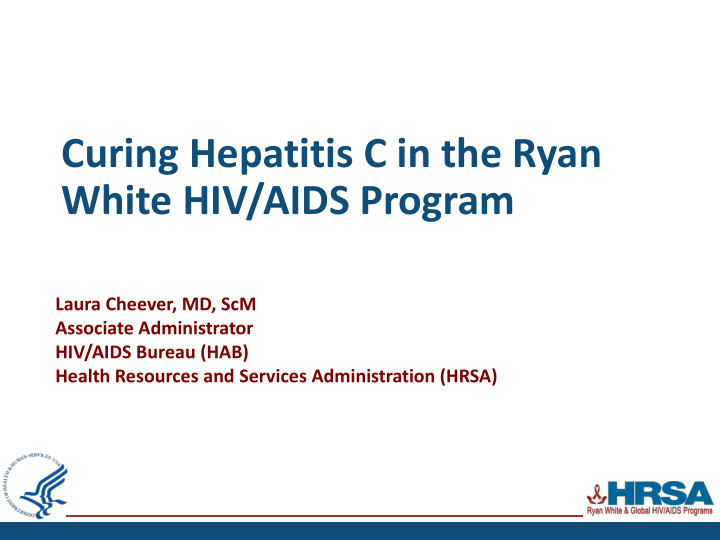



Curing Hepatitis C in the Ryan White HIV/AIDS Program Laura Cheever, MD, ScM Associate Administrator HIV/AIDS Bureau (HAB) Health Resources and Services Administration (HRSA)
Health Resources and Services Administration HIV/AIDS Bureau Vision Optimal HIV/AIDS care and treatment for all Mission Provide leadership and resources to assure access to and retention in high quality, integrated care and treatment services for vulnerable people living with HIV/AIDS and their families 2
Ryan White HIV/AIDS Program • Provides comprehensive system of HIV primary medical care, medications, and essential support services for low - income people living with HIV • More than half of people living with diagnosed HIV in the United States – more than 500,000 people – receive care through the Ryan White HIV/AIDS Program • Funds g rants to states, cities/counties, and local community based organizations • Recipients determine service delivery and funding priorities based on local needs and planning process • Payor of last resort statutory provision: RWHAP funds may not be used for services if another state or federal payer is available 3
Ryan White HIV/AIDS Program – Parts • Parts A (Cities), B (States), C (Community based organizations), and D (Community based organizations for women, infants, children, and youth) Services include: • Medical care, medications, and laboratory services • Clinical quality management and improvement • Support services including case management, medical transportation, and other services • Part F Services • Clinician training, dental services, and dental provider training • Development of innovative models of care to improve health outcomes and reduce HIV transmission among hard to reach populations • 83.4% of Ryan White HIV/AIDS Program clients were virally suppressed in 2015, exceeding national average of 54.7% 4
RWHAP Moving Forward • Public health approach to provide a comprehensive system of care • Ensure low - income people living with HIV (PLWH) receive optimal care and treatment 5
HHS Clinical Priorities • Serious Mental Illness • Substance Abuse • Childhood Obesity 6
Washington Post, October 17, 2017 7
HIV/HCV Coinfection – HRSA Timeline Ending Coinfection in RWHAP SMAIF: Curing HCV SMAIF: HCV & HIV among Jurisdictional ADAP Dear Coinfection People of Approach to Colleague Letter Guide Color Living Curing HCV 2010 2014 with HIV 2015 2017 2006 HCV Affinity Group SPNS Initiative to BPHC Resource Page Expand HCV Treatment 8
Why Should HIV Providers Care A bout HCV? • Many patients have both HIV and Hepatitis C Virus (HCV) • Estimated 20 - 25% of PLWH in the U.S. are co - infected with HCV • Among HIV+ injection drug users (IDUs): up to 80 - 90% are co - infected with HCV (HCV is usually acquired before HIV) • If 20 - 25% are coinfected with HCV, then at least 100,000 HIV/HCV coinfected individuals are served by the RWHAP annually • Having HIV accelerates liver damage • PLWH are dying of liver disease • Liver disease is a leading cause of non - AIDS death among PLWH Ragni MV and Belle SH. J Infect Dis 2001;183:1112 – 5. Weber et al for the D:A:D Study Group. Arch Intern Med. 2006;166:1632 - 1641. Spradling PR et al. J Acquir Immune Defic Syndr 2010;53:388 - 396. Platt L et al. Lancet Infect Dis 2016;16(7):797 - 808. 9
Reflections from my Clinic • Capacity at hand in my practice location • Stigma of HCV and HIV • Success of “closing a chapter” • Those who remain co - infected 10
Curing HCV in the RWHAP – Goals • Identify existing barriers to care (providers and patients) • Increase capacity of HCV surveillance systems • Establish practice model incorporating mental health/substance abuse treatment with HCV care • Defining the HCV care c ontinuum in the RWHAP 11
Curing HCV in the RWHAP – Populations of Focus • Populations of interest include people of color living with HIV who have a high prevalence of coinfection with HCV • Inclusive of blacks/African Americans, Latinos/as , American Indians/Alaska Natives • People who inject drugs (PWID) • M en who have sex with men (MSM) 12
Curing HCV in the RWHAP – Messages • Curing HCV in the RWHAP is achievable • Opportunities to identify challenges in curing HCV among PLWH • Many challenges in curing HCV among PLWH are the same challenges in curing HCV monoinfection • Opportunities to test strategies to overcome those challenges • Partnerships throughout a jurisdiction are needed to cure HCV in the RWHAP • State health agencies’ efforts to cure HCV among PLWH will benefit from partnerships with local health agencies AND with clinics and clinicians • Partnerships with other state agencies, such as those focused on behavioral health 13
Curing HCV in the RWHAP – What You Can Do • Engage your RWHAP counterparts • What is your state RWHAP doing related to HCV/HIV coinfection? • Identify and engage clinicians/thought leaders in your jurisdiction • In what ways can their expertise be shared • Work with community health centers and the primary care associations • Share successful strategies for screening and treatment of HCV • Enhance partnerships • Build upon existing partnerships • Identify new partners throughout your jurisdiction • Leverage media attention and public awareness of the opioid crisis • The opioid crisis extends beyond the use of opioids it includes HIV and HCV 14
Contact Information Laura Cheever, MD ScM HIV/AIDS Bureau (HAB) Health Resources and Services Administration (HRSA ) Email: LCheever@hrsa.gov Web: hab.hrsa.gov Twitter : twitter.com/ HRSAgov Facebook : facebook.com/HHS.HRSA 15
Recommend
More recommend